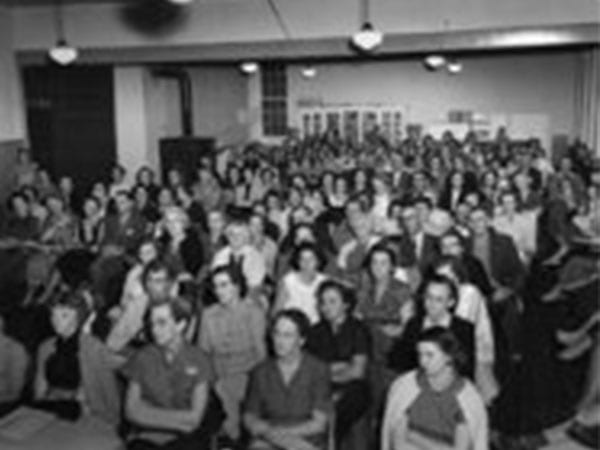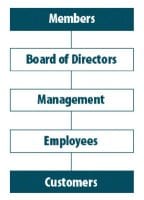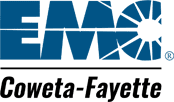History
Coweta-Fayette EMC can trace its history back to 1945 when a group of citizens from Coweta, Fayette and Fulton Counties met to discuss the creation of a new rural electric cooperative.
Distribution lines were purchased from two other EMCs in 1947, and the Cooperative was born. Tremendous growth has occurred since then, and our customer base has increased from the original 691 members to over 90,000 currently. Today, EMC serves one of America’s fastest-growing communities with a progressive attitude toward the provision of power and customer service. From residential and commercial to our industrial community, all of our customers are both members and owners of EMC; we work hard to provide them with dependable, economical service.
Policies for the EMC are set by the Board of Directors – nine member/owners who represent three districts, serve three-year terms and are elected by members at the Annual Meeting in October. The Cooperative is financed by loans from the National Rural Utilities Finance Corporation (CFC), the Rural Electrification Administration (REA), and paid-in capital from our member-owners.
As a locally owned and managed company, we’re always available to meet your day-to-day needs. However, we’re constantly investing in new technology and conducting groundbreaking research because we’re also preparing for a sound future. With our ability to help all of our members meet their energy needs, the future looks bright for Coweta-Fayette EMC and its partners.


Investing to Serve You Better
Coweta-Fayette Electric Membership Corporation has the best electric system that money, skill, and devotion can provide. Most of our investment is in our electric system. Our substation costs can be as high as $450,000, and each meter costs about $30. Our average investment to serve one member (including poles, wire, transformers, etc.) is approximately $2500.
To provide you with the most efficient service, EMC maintains a fully stocked warehouse so that construction or repairs can easily be made over our entire system. We also use the most modern methods to bill for service. Our radio-dispatched trucks utilize the most up-to-date safety devices and equipment for line work, and are available around the clock. Your EMC has also added new emergency trucks, dubbed the “Power Rangers,” which respond to your calls within 45 minutes. Designed to supplement our other emergency teams, they can handle small repairs or arrange for more assistance.
Our Relationship with Oglethorpe Power Corporation
EMCs were originally established as distribution systems, responsible for purchasing wholesale electricity from power suppliers and then distributing it to member-consumers. As demand increased and wholesale electric power costs skyrocketed, 39 of Georgia’s EMCs, including your EMC decided to join together and go into the generation and transmission business. In August, 1974, they established Oglethorpe Power Corporation.
Since that time, Oglethorpe has grown into a $5.4 billion corporation. It owns 138,000 miles of high voltage transmission lines and has a generating capacity of 2,703 megawatts. This includes 30% undivided interest in the following generating plants: Hal B. Wansley Fossil Plant, Edwin I. Hatch Nuclear Plant, Alvin W. Vogtle Nuclear Plant, (60%) Bob Scherer Fossil Plant. It is also the principal co-owner of the Rocky Mountain Project, a pumped storage hydroelectric facility.
In 1997, Oglethorpe was divided into three separate companies in order to provide our members with better service at a lower cost. The first, Oglethorpe Power Corporation, is responsible for generating power; it also handles marketing and economic development. The second, Georgia Transmission Corporation, handles the transmission of power, including managing high voltage lines and substations. The third and final company is Georgia Systems Corporation, which manages the power plant control rooms and handles the dispatching of power. All three companies are owned by the EMCs and each is governed by its own board.
Capital Credit
While EMC is a non-profit cooperative, we are required to have some margins to prove that we are a sound business. These margins, above operating costs, are called Capital Credit. Each member has a separate Capital Credit account and is assigned a percentage of these margins based on the amount he/she pays to the Cooperative. Our Board of Directors believes that member/owners should receive a portion of this money back when our financial condition permits.
Publications
We provide several ways for you to stay informed about Coweta-Fayette EMC’s progress and to exercise your right to participate in managing what is essentially your business. As a member of the EMC, you will receive our newsletter, Powerlines. It contains helpful articles on electricity and energy efficiency, as well as information on special programs and members of our staff.
Prior to the Annual Meeting, we print an Annual Report which lets you know – through text, statistics, and graphs – how we fared during the preceding year. The Annual Meeting is held in October and allows each member to vote on how the EMC is run, as a business. Members like yourself serve on the Board of Directors and are elected by members to represent your interests. We encourage you to attend this important event and to make your voice heard.
EMC Facts at a Glance
- Incorporated October 25, 1945, in Newnan
- Services more than 73,500 meters
- Operates 6,113 miles of line
- Has paid more than $85,630,597 in ad valorem taxes to counties in which it serves.
- Has borrowed approximately $208,414,175 from RUS and CFC
- Employs 199 local citizens
- Holds Annual Members Meeting in October


